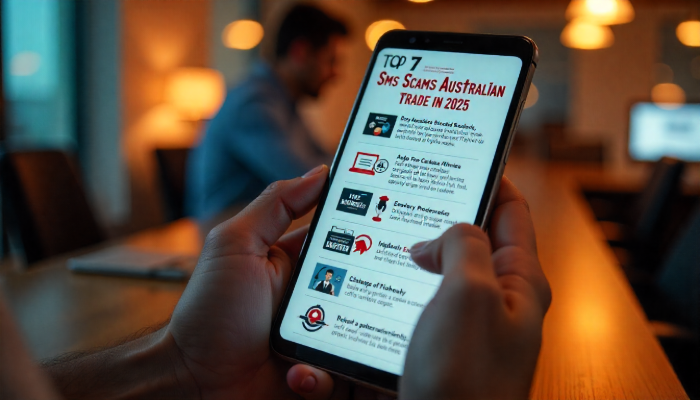Top 7 SMS Scams Australians Must Avoid in 2025 – Real Examples & Safety Tips


Top 7 SMS Scams Australians Must Avoid in 2025
📌 TL;DR — 7 SMS Scams to Watch Out For in Australia (2025)
Fake parcel fees — links to cloned courier sites stealing your card & ID.
Banking text fraud — spoofed SMS in your real bank thread asking you to log in.
ATO tax refund/debt — fake myGov links collecting personal details.
Telco suspension notices — fake payment portals & SIM-swap traps.
Job offer texts — upfront fees for fake remote work roles.
Prize draw messages — “win” a voucher, but pay fees or give card details.
Charity disaster appeals — fake donation requests after floods/fires.
Tip: Pause before clicking any link in a text. Always verify using official websites or phone numbers you look up yourself.
Australia’s Growing SMS Scam Problem in 2025
In 2025, SMS scams — also called “smishing” — are more convincing than ever. Scammers now use AI-written messages, legitimate-looking URLs, and even message thread spoofing so their texts appear alongside genuine ones from your bank, telco, or delivery service.
According to the National Anti-Scam Centre, SMS scams were the fastest-growing delivery method for phishing attacks in 2024, costing Australians tens of millions of dollars. Early 2025 data suggests that while overall scam reports are down, losses per successful SMS scam are rising — meaning scammers are targeting fewer people, but hitting them harder.
1. Fake Parcel Fee SMS Scams
What it looks like:
“Your package is waiting. Pay $3.95 redelivery fee here: [fake-link.com]”
Often branded as Australia Post, DHL, or FedEx.Why it works in 2025:
Many people are ordering online more than ever. Scammers exploit this by sending mass texts, knowing a large percentage will have genuine pending deliveries.How they get you:
The fake payment page steals card details and often identity info like date of birth and address. Some campaigns escalate by calling victims, pretending their account is compromised.How to stay safe:
Track parcels through official courier websites or apps only.
Never pay delivery fees from a link in a text.
2. Banking Text Fraud (Spoofed SMS)
What it looks like:
Text appears inside your legitimate bank SMS thread saying:
“We’ve detected suspicious activity. Log in immediately: [fake-bank-link.com]”Why it works:
Scammers use SMS spoofing so their text appears as if it’s from your actual bank. The link leads to a perfect replica of the login page.How they get you:
Once you enter credentials, scammers immediately log into your real account and attempt high-value transfers.How to stay safe:
Banks will never include clickable login links in SMS.
Type your bank’s website manually or use their official app.
3. ATO Tax Refund or Debt Scams
What it looks like:
“You are owed $256.73 by the ATO. Claim here: [fake-mygov-link.com]”
Or: “You owe $1,542.34 in unpaid tax. Pay immediately to avoid legal action.”Why it works:
Many Australians deal with tax refunds and debts during EOFY, making it easy for scammers to blend in.How they get you:
The link leads to a fake myGov login page to harvest credentials and personal details.How to stay safe:
Log into myGov only by typing the URL yourself or using the official app.
The ATO does not demand payment via SMS.
4. Telco Suspension & SIM-Swap Scams
What it looks like:
“Your Telstra/Optus/Vodafone account is suspended due to non-payment. Pay now: [fake-link.com]”Why it works:
Losing phone service is urgent — scammers rely on fear to push immediate payment.How they get you:
Fake payment pages harvest card details.
Some escalate to SIM-swap fraud, taking over your number to intercept banking codes.How to stay safe:
Contact your telco using the number on your bill or official site.
Add a port-out PIN with your provider for extra security.
5. Job Offer Text Scams
What it looks like:
“We are hiring part-time product reviewers. Earn $300/day. Apply now: [fake-link.com]”Why it works:
Remote work demand is high, and scammers target job seekers with fake offers.How they get you:
Victims are asked to pay an “onboarding fee” or provide ID/bank details for fake payroll.How to stay safe:
Legitimate employers never request upfront payments for training or equipment.
Verify job postings directly with the company.
6. Prize Draw & Voucher Text Scams
What it looks like:
“Congratulations! You’ve won a $500 Coles gift card. Claim here: [fake-link.com]”Why it works:
Uses excitement and urgency to override scepticism.How they get you:
You’re asked to pay a “small delivery fee” or complete forms that harvest payment & ID details.How to stay safe:
If you didn’t enter, you didn’t win.
Confirm directly with the retailer through their website.
7. Charity & Disaster Appeal SMS Scams
What it looks like:
“URGENT: Donate now to help flood/fire victims. Every dollar counts. [fake-link.com]”Why it works:
Scammers exploit real disasters, copying the branding of known charities.How they get you:
Links lead to fake donation pages that steal card details.How to stay safe:
Donate only via official charity websites or known platforms.
Verify ABN registration via the ACNC Charity Register.
Final Tips for 2025
Slow down — urgency is the scammer’s best weapon.
Verify independently — type official addresses, don’t click SMS links.
Report every attempt to Scamwatch and your provider — it helps block future campaigns.
For More interesting blogs click here ....
Safety
Empowering families to navigate online risks securely.
Community
“CyberShield Academy © 2025. All rights reserved.”